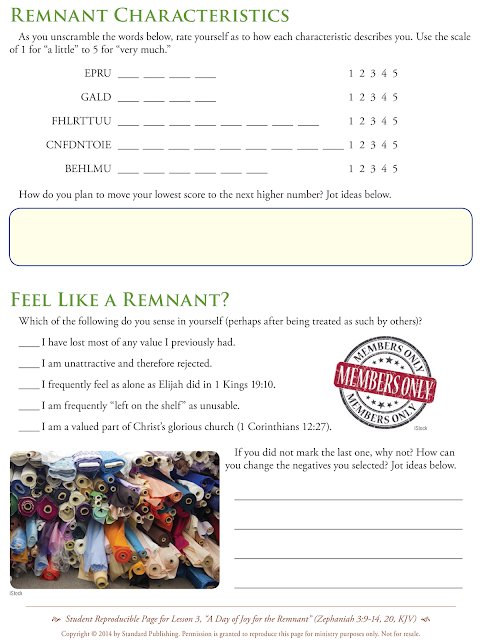June 19
Lesson 3
A DAY OF JOY FOR THE REMNANT
DEVOTIONAL READING: Hebrews 11:29–39
BACKGROUND SCRIPTURE: Zephaniah 3:9–20
ZEPHANIAH 3:9–14, 20
9 For then will I turn to the people a pure language, that they may all call upon the name of the LORD, to serve him with one consent.
10 From beyond the rivers of Ethiopia my suppliants, even the daughter of my dispersed, shall bring mine offering.
11 In that day shalt thou not be ashamed for all thy doings, wherein thou hast transgressed against me: for then I will take away out of the midst of thee them that rejoice in thy pride, and thou shalt no more be haughty because of my holy mountain.
12 I will also leave in the midst of thee an afflicted and poor people, and they shall trust in the name of the LORD.
13 The remnant of Israel shall not do iniquity, nor speak lies; neither shall a deceitful tongue be found in their mouth: for they shall feed and lie down, and none shall make them afraid.
14 Sing, O daughter of Zion; shout, O Israel; be glad and rejoice with all the heart, O daughter of Jerusalem.
20 At that time will I bring you again, even in the time that I gather you: for I will make you a name and a praise among all people of the earth, when I turn back your captivity before your eyes, saith the LORD.
Photo: Naomi Bassitt/iStock/Thinkstock
KEY VERSE
Sing, O daughter of Zion; shout, O Israel; be glad and rejoice with all the heart, O daughter of Jerusalem.
—Zephaniah 3:14
TOWARD A NEW CREATION
Unit 1: Judgment and Salvation
LESSONS 1–3
LESSON AIMS
After participating in this lesson, each learner will be able to:
1. List characteristics of “the remnant of Israel.”
2. Describe specific qualities that people who are part of the remnant should demonstrate daily.
3. Suggest a specific way that he or she will demonstrate at least one quality from that list in the coming week.
LESSON OUTLINE
Introduction
A. Saving the Remnant
B. Lesson Background
I. Purified People (ZEPHANIAH 3:9–14)
A. Unified (vv. 9, 10)
B. Trusting (vv. 11, 12)
“Have You No Shame?”
C. Unafraid (v. 13)
Looking for an Honest Man
D. Glad (v. 14)
II. Precious Promises (ZEPHANIAH 3:20)
A. Gathered by God (v. 20a)
B. Praised by People (v. 20b)
Conclusion
A. “When Are We Going Home?”
B. Prayer
C. Thought to Remember
HOW TO SAY IT
Babylon Bab-uh-lun.
Deuteronomy Due-ter-ahn-uh-me.
Diogenes Die-ah-jin-eez.
Ezra Ez-ruh.
Isaiah Eye-zay-uh.
Jeremiah Jair-uh-my-uh.
Sinope Suh-nawp.
Zephaniah Zef-uh-nye-uh.
______________________________________________________
What Do You Think?
What can you do to promote Christian unity?
Talking Points for Your Discussion
■ Regarding unity of purpose at the local level
■ Regarding unity of purpose beyond the local level
■ Regarding unity of practice
■ Other
______________________________________________________
What Do You Think?
Where are Christians most in danger of becoming haughty? How do we address this problem?
Talking Points for Your Discussion
■ Concerning church affiliation or membership
■ Concerning an area of service to the Lord
■ Concerning personal accomplishments
■ Other
______________________________________________________
What Do You Think?
How can we keep from letting fear of the world control our attitudes and actions?
Talking Points for Your Discussion
■ Regarding ungodly influences on family members
■ Regarding national trends
■ Regarding financial security
■ Other
______________________________________________________
What Do You Think?
Who is an example of the kind of joy of which the Scriptures often speak? How does this individual’s example help you discover joy?
Talking Points for Your Discussion
■ Biblical examples
■ Personal acquaintances
■ Christians about whom you’ve read or heard
■ Other
______________________________________________________
What Do You Think?
What are some ways to improve your church’s witness among all people (s) of the earth?
Talking Points for Your Discussion
■ Steps individuals can take
■ Steps families can take
■ Steps the congregation as a whole can take
■ Other
______________________________________________________
Visual for Lesson 3. As you discuss the lesson’s Conclusion, point to this visual and ask, “What do you anticipate most about Heaven?”
When a person becomes a Christian, he or she “comes home” to God in a very real sense. Even so, we are not yet fully home with the Lord until Jesus returns. In the meantime, we take care not to get too attached to the present world, which is destined to pass away (2 Peter 3:10–13). If we have not yet adjusted our thinking to this future reality, we must do so! A greater homecoming awaits us, a homecoming that Zephaniah’s concluding words foreshadow.
______________________________________________________
Redford, Douglas, Charles R. Boatman, et al. “A Day of Joy for the Remnant.” The KJV Standard Lesson Commentary, 2015–2016. Ed. Ronald L. Nickelson and Jim Eichenberger. Vol. 63. Cincinnati, OH: Standard Publishing, 2015. 367. Print.



Comments